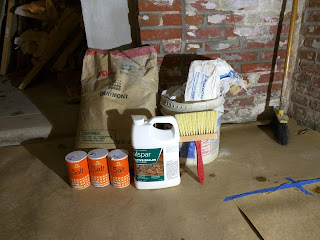White Washing Basement Walls
In Philadelphia, there are many a damp basement. And people are determined to keep the dampness at Bay. The dampness creeps from the soil and through the lime and clay mortar that holds the foundation stones together. I've seen people paint the walls with white drylock paint or apply acrylic exterior finish stucco. Those solutions never end well since they hold the moisture in the foundation wall, causing deterioration or mold just behind the paint or stucco. There are some better products that allow the wall to breathe, but I prefer whitewashing basement walls if the parging is in good shape. Whitewash allows the walls to breathe and it doesn't trap water behind the whitewash application. With whitewash, moisture just appears as a darker spot on the wall which will appear or disappear depending on how much it rains and wicks moisture into the foundation. And that dark spot allows the moisture to evaporate from the surface. There are various recipes that can be found online. Most recipes contain salt and lime. Other ingredients can be white portland cement, molasses, laundry bluing.. etc... I've developed a mix that I like and deviates slightly from tradition. So here is what you will need.
-A 50 lb bag of autoclaved finish lime
-Valspar protective sealer as a binder
-About 10 pounds of table salt
-A 50 lb bag of autoclaved finish lime
-Valspar protective sealer as a binder
-About 10 pounds of table salt
-One bad of white portland cement
-A Mason's brush
You will also need some measuring containers. A 16oz coffee cup and a one-gallon bucket should do well. You need a mixing paddle for a cordless drill or a large mixing drill and mixing paddle. You need a five-gallon bucket. The recipe I will give you is for small manageable batches. And rubber gloves are a good idea, finish lime is not great for your skin and can cause irritation.
Recipe
Fill your five-gallon bucket half full of hot water. Add 16oz of table salt to the hot water and dissolve into the water by stirring. Add 24 ounces of the white cement and then follow that with 24 ounces of the Valspar protective sealer. Mix until the cement is not clumpy. Then add 3 and a quarter gallons of the autoclaved finish lime to the mixture and mix with a heavy drill and mixing paddle until it reaches a non-clumpy paintable consistency. Your whitewash is ready to go.
Sweep your walls down to free them of any dust and debris which will prevent the adhesion of the new whitewash application. First, dampen your walls a little using a hose with a sprayer nozzle. Don't soak them. Use your Mason's brush to apply the whitewash. Allow it to dry on the wall and then apply consecutive coats. You may need to apply up to three coats. The whitewash will harden over 30 days and will keep humidity from making your walls deteriorate and allow moisture within your wall to escape and keep your old foundation wall nice and healthy for many years to come. Good luck!!


Comments
Post a Comment